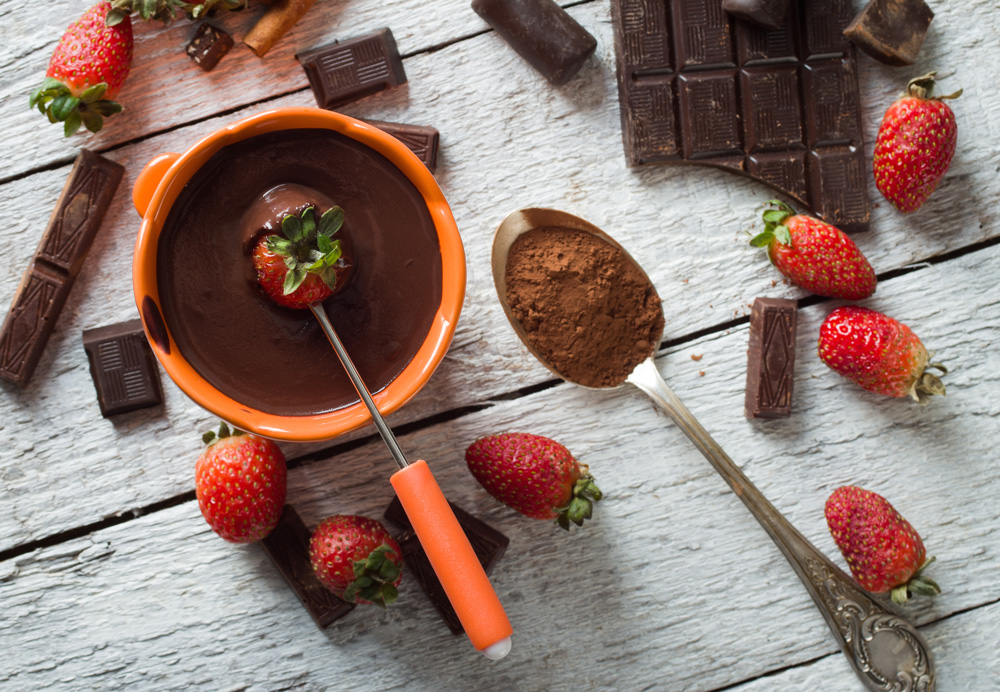 Sure, there’s still time. All you need is a double boiler, some chocolate, a few well-chosen things to dip into that chocolate, and some patience.
Sure, there’s still time. All you need is a double boiler, some chocolate, a few well-chosen things to dip into that chocolate, and some patience.
Parchment paper works well as a cooling area/landing pad. You can move the chocolates easily off it once they’re set.
Lehman’s offers two models, the Double Boiler, and the Stainless Steel Double Boiler. I prefer the Stainless Steel Double Boiler because of its squared-off lid handle and three-ply steel lower pan. They’re well matched, though, and choice comes down to small preferences.

First, the chocolate
No matter what you’ve heard, your chocolate doesn’t have to be fancy-schmancy ‘coating’ chocolate. In fact, you can melt and use just about any chocolate that you like, including chocolate chips with which you may normally bake–as long you’re careful about how you melt the chocolate. Use a plain chocolate–one with nuts or other ‘lumpy’ ingredients will be difficult to melt and incorporate smoothly.
In a double boiler, the water in the bottom pan shouldn’t get much hotter than a gentle simmer, and should NEVER touch the bottom of the top pan. The top pan will overheat quickly if it does, and your chocolate will burn and be ruined. Only put an inch or two of water in the bottom pan, and check it between batches. Add water if needed, so it doesn’t steam itself dry.
Your chocolate should be chopped into roughly equal pieces. Divide the quantity into thirds, if you’re using more than a standard size candy bar. Add it to the top pan in batches, making sure the first batch is completely melted before adding the second. Once the second is melted into the first, add the third.
Stir constantly as the chocolate is melting, and keep an eye on the water in the bottom pan. If it gets too hot, your chocolate may scorch. You can remove the double boiler from the heat to cool things down, and even separate the pans temporarily, if needs be.
For step-by-step melting instructions, check out this link. The chef’s using an industrial-sized chocolate bar, and a makeshift double boiler, but the principles and techniques are similar.
Be sure you never, ever get water or other liquids in your melted chocolate. This will cause it to seize, and it’ll harden up and become unusable.
Make sure your ‘landing pad’–a cookie sheet or countertop covered in parchment paper–is ready to go before you start to melt the chocolate for each treat. You can’t leave melting chocolate unattended. It can overheat and scorch before you know it.
CHOCOLATE COVERED PEANUTS
These are the easiest to do. If you make unsalted and salted chocolate covered peanuts, make sure you can tell them apart when you serve them. Some folks favor one over the other.

Place about 6 ounces peanuts in a medium to large heat-safe bowl.
Add 4 to 6 ounces melted chocolate to peanuts. (Chocolate quantity will depend on peanut size.)
Stir until just coated, and drop in tablespoons on a parchment-paper lined cookie sheet.
Or, if you prefer, drop by teaspoonfuls into small paper cups.
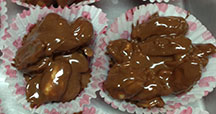
Work quickly, the chocolate will start to set when it hits the room-temperature peanuts. When peanuts are cool and set firmly, pack in jars.
If you like, wrap nuts or nut cups in small plastic wrap or cellophane squares before you pack them in the jars to protect the shiny chocolate coating.
CHOCOLATE-DIPPED POTATO CHIPS
Again, an easy treat to make. The amount of chocolate you’ll need depends on the amount of chips you want to dip. I used nearly three pounds of chocolate when I dipped a case of Gold’N Krisp chips for a chocolate-themed ‘candy bar’ at a wedding.
First, lay out your chips, and select the nicely sized whole chips. Layer them between paper towels, so any extra oil can be wicked away.
Second, melt your chocolate as above.
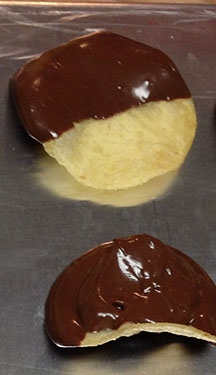
Third, once the chocolate is melted, remove the top pan from the bottom pan of the double boiler. Place it on a towel near your landing pad area, and dip away. You may have to tilt the pan to get coverage as you go along. Let each chip stop “dripping” chocolate before you move it to the landing pad, otherwise, the extra chocolate will pool around the chip, and it won’t look very pretty.
Pack set, cooled, finished chips in airtight jars or zippered bags, to keep them fresh.
You can dip your chips directly in the melted chocolate pan, but I’d recommend washing, thoroughly drying and melting fresh chocolate if you run out of chocolate before all your chips are done. The oil from the chips can break down the chocolate a bit, and make it harder to coat the chips if you’re doing a big batch.
CHOCOLATE-COVERED POPCORN
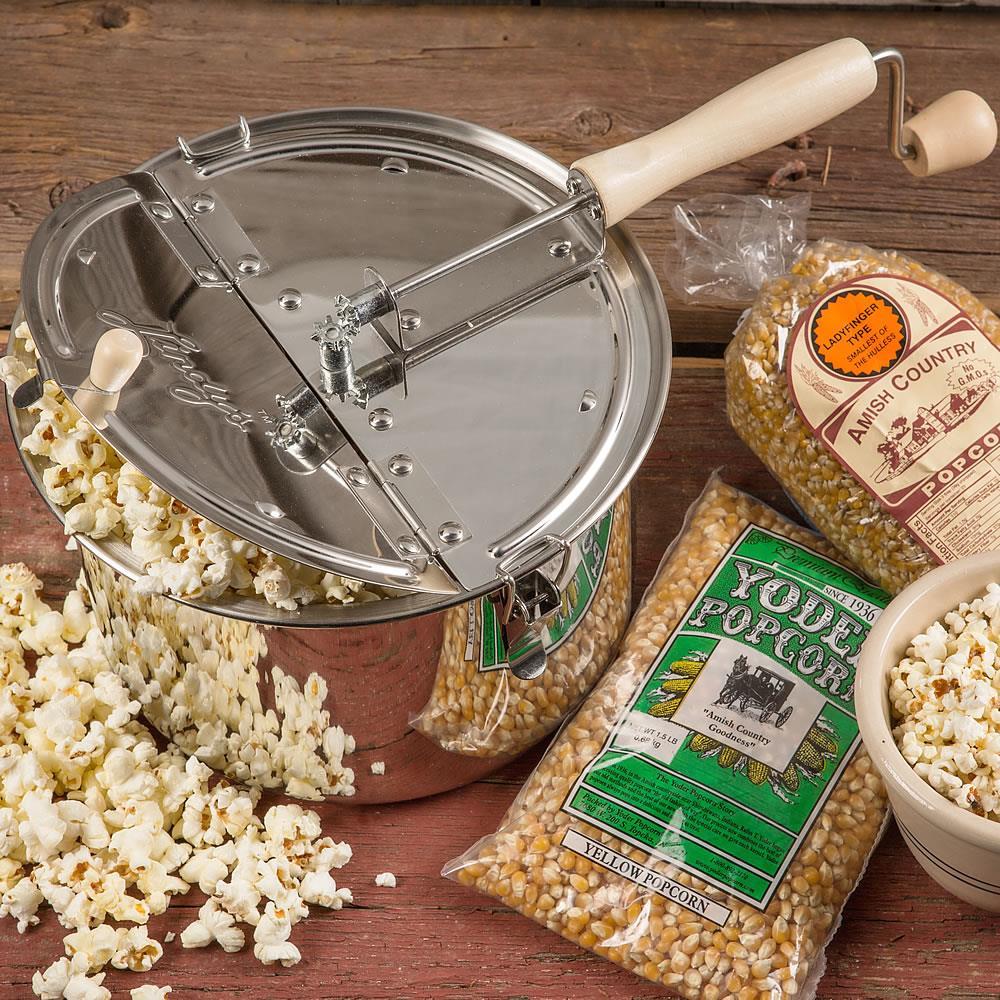 Again, another easy-peasy treat!
Again, another easy-peasy treat!
Pop your corn on the stovetop, and pour it out on a single layer over your landing pad or directly into a cookie sheet to cool.
Melt a small amount of chocolate. When melted, move the chocolate pan to a towel near the landing pad.
Using a large spoon, or meat fork (we call them ‘granny forks’ here at Lehman’s), dip the utensil 1/3 of the way into the chocolate, and swing ‘strings’ of chocolate over the popcorn.
A little chocolate can go a long way, and be careful how hard you swing. If you miss the pan, you’ll be surprised how chocolate can travel. You can also pour the chocolate into a squeeze bottle, and squeeze it over the popcorn. I find the transfer into the bottle tedious and messy, though, and use the fork-dip-and-swing method.
You’ll have to break up the cooled, set batch into serving sizes. Pack in sandwich bags, cellophane, or plastic wrap. Keep in airtight container, the corn can go stale quickly. This is a quick, economical alternative to cookies for a classroom treat.
WHAT ELSE CAN YOU DIP?
Candy fruit slices: For the person with a real sweet tooth. The orange ones are really good, although rich. The cherry ones are tasty too.
Pretzels of all kinds
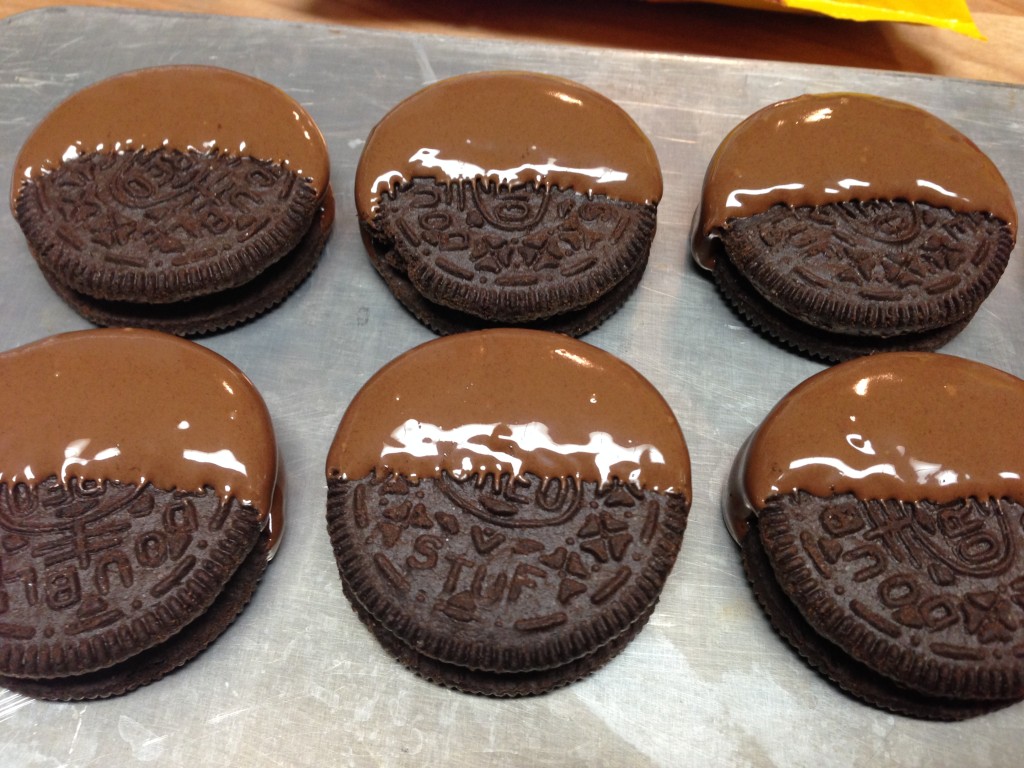
Cookies: Those store bought sandwich ones, with the white filling or the peanut butter filling do well, as do shortbread-based home-made recipes.
Fruit: Strawberries, grapes, oranges/tangerine/grapefruit slices with membrane removed, kiwi…the list is endless. Make sure fruit is as dry as you can make it, and dip into a bowl of melted chocolate. Never dip fruit into your melting pot. If it’s not dry enough, you can seize and ruin an entire batch.
Bacon: Yep. Bacon. By the strip, or crumbled and coated like the peanuts.



























